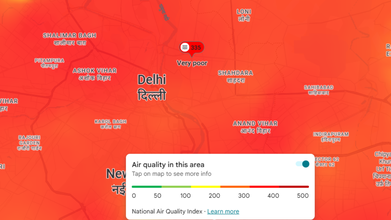- Health Conditions A-Z
- Health & Wellness
- Nutrition
- Fitness
- Health News
- Ayurveda
- Videos
- Medicine A-Z
- Parenting
- Web Stories
Russian Cancer Vaccine Enteromix Could Prevent Colon Cancer, Details Inside

Credits: Canva
Russian scientists have unveiled a breakthrough that could transform colon cancer prevention and treatment worldwide. The Federal Medical and Biological Agency (FMBA) announced that its researchers have developed a vaccine targeting colorectal cancer, one of the most common and deadly cancers globally. The vaccine, named Enteromix, is based on mRNA technology, the same method used successfully in COVID-19 vaccines, and is now ready for clinical use.
FMBA head Veronika Skvortsova revealed the development at the 10th Eastern Economic Forum in Vladivostok, which brought together more than 8,400 participants from over 75 countries. According to Skvortsova, the vaccine has undergone years of research, including three years of preclinical trials, and is showing promising results.
How The Colon Cancer Vaccine Works
Enteromix uses genetic instructions to teach the body’s immune system to recognize and destroy cancer cells before they form dangerous tumors. Scientists compare it to handing the immune system a “wanted poster” of colorectal cancer cells. If such cells ever appear, the immune system attacks them immediately, preventing the tumor from growing.
Also Read: Björn Borg Shares His Experience Of Living With Prostate Cancer
This approach was tested in lab mice bred to develop colon cancer, where the vaccine achieved a remarkable 100% success rate in preventing tumor formation. Early human trials have also been completed, with volunteers tolerating the vaccine well and no serious side effects reported.
Promising Results from Preclinical Trials
The preclinical trials revealed more than just prevention. In some test subjects, existing tumors shrank or slowed their growth by 60% to 80%, depending on the cancer type. Researchers also noted improved survival rates, sparking hope that Enteromix could be used both preventively and therapeutically in the future.
Work is already underway to develop similar vaccines for other forms of cancer, including glioblastoma (a highly aggressive brain cancer) and certain types of melanoma, including ocular melanoma, which affects the eye.
Why This Matters Globally
Colorectal cancer is the third most common cancer worldwide, with rising incidence rates in many developing nations. In countries like Rwanda, cases have risen by more than 70% in the past decade, often affecting young patients who are diagnosed at late stages due to the lack of national screening programs. Late diagnosis makes treatment more difficult and survival rates much lower.
For regions with limited access to screening and treatment facilities, a preventive vaccine could be a public health game-changer. It could help bridge health equity gaps and save countless lives by offering a way to protect vulnerable populations before cancer takes hold.
What Lies Ahead?
Despite the excitement, scientists are cautious. History has shown that promising animal results do not always translate perfectly to humans. Large-scale Phase III clinical trials will be crucial to confirm Enteromix’s effectiveness and safety in diverse populations.
Still, Russia has announced plans to roll out the vaccine in the coming weeks, free of charge, marking an important milestone in global cancer research. If successful, Enteromix could offer hope to millions and usher in a new era where certain cancers can be prevented much like infectious diseases.
What's New In Trump's Health? A Recent 'Perfect' MRI Scan And The Will To Serve A 'Third Term'

Credits: Wikimedia Commons
President Donald Trump underwent an MRI scan in the last health checkup, which was supposedly a routine health check-up. However, top American cardiologist Dr Jonathan Reiner, who is also a professor of medicine at George Washington University and former cardiologist to ex-vice president Dick Cheney told CNN that MRIs are "never performed as part of a routine check".
This has led to many more health speculation, especially after Kai Trump's photo showed his bruised hand, covered with makeup, revealing the vein damage.
Why Did The President Get An MRI Scan?
Reiner says that MRI scans are typically prompted by symptoms. "They can be neurologic symptoms that prompt an MRI. They could be back pain that prompts an MRI. There can be issues with the heart that would prompt an MRI. And for those reasons, the public should really be told, you know, why did the president undergo the test, what consultants he saw, and what was the result of testing?"
However, when asked by reporters abroad Air Force One on Monday about the reason for this scan, the president declined to tell them the reason that his doctors had ordered the scan, reported the New York Times.
He said that the results were "perfect" and he redirected the questions to his doctor stating, "I gave you the full results, We had an MRI... you know the whole thing. And it was perfect."
However, Reiner disagrees with his and says, "An MRI is never part of a routine evaluation, whether you are president of the United States or whether you are just a civilian."
The opinions were seconded by Dr Vin Gupta, MD, at Institute for Health Metrics and Evaluation (IHME). He wrote on his twitter post, "Even if you are leader of the free world, you don't just get an MRI without a clear reason to do so. there is no such thing as a "screening" MRI." He was however, contradicted by another MD Nicole Saphier, who called his claims false.
Third Term The President Would Love To Serve
While the Constitution limits presidents to two terms. Trump does not really care. He said that he would love to do a third term. "I would love to do it. I have my best numbers ever. It is very terrible. I have my best numbers."
Why Is This MRI Scan A Big Deal?
What makes this a big deal is because Donald Trump had gotten his medical checkup done earlier this month. The tests and the summary was released by the White House physician Dr Sean P Barbabella. The tests happened at the Walter Reed National Military Medical Center. However, no such detail about the MRI scan was mentioned, for which the president also mischaracterized the summary released by his physician, saying that he gave the doctor his full results.
An MRI is usually used as a noninvasive technology to create detailed images of the inside of the body for disease detection and monitoring, or to detect bone or joint abnormalities. If his medical reports were perfect, then what did he need an MRI scan for?
F.D.A. Approves New Non-hormonal Menopause Drug To Reduce Hot Flashes

Credits: Canva
Menopause is often seen as the end of womanhood by many women, however, as Dr Archana Nirula, a gynaecologist & obstetrician, who specializes on women’s health, says, "menopause is not the end of woman's life". Thanks to the new drug Lynkuet, finally approved by the US Food and Drug Administration, women can now actually believe so.
This is a nonhormonal medication, designed to treat hot flashes and night sweats in menopausal and perimenopausal women. The drug is developed by Bayer, and its main compound is elinzanetant. This is a novel therapy that could also help improve sleep disturbances commonly linked to menopause.
Why Is This Medicine A Breakthrough?
While most medicines treating menstrual-relating symptoms for women are heavy doses of hormones, leading to many side effects, Lynkuet stands out. It offers relief without using hormones, a much-needed alternative for women who cannot or prefer not to take hormone therapy.
What's Wrong With Hormonal Drugs?
while hormone replacement therapy (HRT), usually estrogen and progesterone, remain effective for many, it is not suitable for everyone. Women with a history or high risk of breast and ovarian cancer, or those wary of hormone-related side effects, often seek for better, safer and nonhormonal options.
Until recently, those options were extremely limited. The first nonhormonal drug, Veozah (fezolinetant), was approved in 2023, targeting only one type of brain receptor linked to temperature regulation. Before that, doctors mostly relied on low-dose antidepressants like paroxetine to manage hot flashes, an off-label approach with limited benefits.
How Does Lynkuet Work?
What makes this medicine different is the way it works on the brain. The drug is responsible for blocking two types of neurokinin receptors, namely: NK1 and NK3. These neurokinin receptors play a key role in regulating body temperature, mood, and sleep. By doing so, elinzanetant helps restore balance in the hypothalamus, which is brain's temperature control center. This usually becomes disrupted when estrogen levels fall during menopause.
This dual-action mechanism is what sets Lynkuet apart. Unlike Veozah, which targets only one receptor, elinzanetant’s two-receptor approach could mean broader benefits, not just reducing hot flashes and night sweats, but also improving sleep quality, which many women struggle with during perimenopause and menopause.
How Did It Pass The Clinical Trials?
Clinical trials for Lynkuet involved women aged 40 to 65 who experienced frequent and severe hot flashes. According to researchers, symptom relief began as early as one week after starting treatment.
By week 12, over 70% of women taking elinzanetant reported at least a 50% reduction in the frequency of hot flashes, compared to just over 40% in the placebo group. Sleep quality also improved significantly, with many participants reporting fewer disturbances at night.
At 26 weeks, the benefits persisted, more than 80% of participants maintained a 50% reduction in symptom frequency. Those who initially received the placebo and later switched to the drug showed similar improvements, underscoring its consistent efficacy.
Are There Any Side Effects?
The most common side effects reported are mild headache, fatigue, and joint pain. A few participants also reported elevated liver enzyme levels, however there was no serious toxicity observed.
Delhi Air Pollution: 3 out of 4 households in Delhi-NCR Face Some Kind Of Pollution-Related Health Issues, Finds Survey

Credits: AQI/googlemaps.com
As per the India Meteorological Department (IMD), Delhi recorded a minimum temperature of 17.3 degree Celsius, which is 0.1 degrees above the season's average. While the maximum temperature is expected to be around 29 degree Celsius, there is a rain forecast too, with humidity level at 94% at 8.30 am on Monday. Despite this, the air pollution continues to persist, thanks to the thick layer of smog and persisting air pollution. The firecrackers continue to burst even days after Diwali, in fact, as notes the Indian Rice Exporters Federation, stubble burning incidents have declined by 68% in North India, this year. Despite all, Delhi has still recorded the most toxic post-Diwali air in five years, as per the Central Pollution Control Board (CPCB) data.
Pollution Levels In Delhi
- As per the National Air Quality Index, as of 6.30 am, Anand Vihar recorded an AQI of 348, putting it under the 'very poor' category.
- Kashmere Gate recorded AQI of 299, under 'poor' category
- Rohini recorded an AQI of 346, under 'very poor' category
- Nangal Thakran, an area in Delhi recorded an AQI of 401, placing it under 'severe' category
- ITO recorded an AQI of 336, placing it under 'very poor' category
- Nazafgarh recorded an AQI of 307, placing it under 'very poor' category
- Azadpur recorded an AQI of 351, placing it under 'very poor' category
Health Impact Due to 'Very Poor' AQI
As per a recent survey, conducted by LocalCircles, based on the data from the CPCB, as reported by PTI, after Diwali, PM2.5 levels touched 488 micrograms per cubic metre. This is the highest in five years and over three times the pre-festival level of 156.6 micrograms per cubic metre.
The pollution levels rose on Diwali night on October 20 and next day in early morning.
The survey analyzed responses from residents across Delhi, Faridabad, Noida, Gurugram and Ghaziabad, to reveal that 42% of the households reported that one or more members had a sore throat or a persisting cough. The survey also notes that 25% of the family members suffered from conditions like burning eyes, headaches, and difficulty sleeping. 17% of them reported breathing difficulties or aggravated asthma.
As per the LocalCircles survey, 44% of households are trying to reduce their outdoor exposure and increase the intake of immunity-boosting foods and drinks to cope with poor air quality. However, as Health and Me reported previously, even the air inside the house is not safe to breathe.
Studies have found that air inside the city homes have 12 times more fungal spokes than the WHO safety limits. They can cause skin allergies, respiratory issues, and anxiety. As per a 2021 study by the Energy Policy Institute at the University of Chicago (EPIC India), PM 2.5 levels for low-income and high-income households in Delhi were high during the winters. The concentrations reported 23 and 29 times higher than the WHO safe limits, respectively. These findings also suggested that high-income households were 13 times more likely to own air purifiers than low-income households. Another study titled Microbial Indoor Air Quality Assessment and Health Correlations in Densely Populated Urban Areas of Delhi, India found that fungal and bacterial levels inside homes were several time higher than the World Health Organization (WHO)'s safe limits.
Read More: Think You’re Safe Indoors? Study Says Delhi’s Winter Pollution Follows You Home
How Can You Read AQI?
As per the CPCB, here's how the data on AQI can be interpreted
- 0-50 is considered ‘good’
- 51-100 is considered ‘satisfactory’
- 101-200 is considered ‘moderate’
- 201-300 is considered ‘poor’
- 301-400 is considered ‘very poor’
- 401-500 is considered ‘severe’
© 2024 Bennett, Coleman & Company Limited

